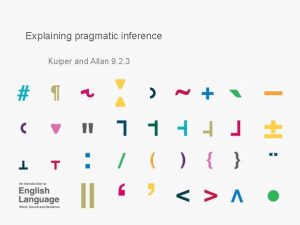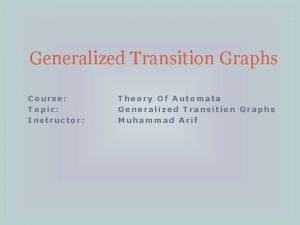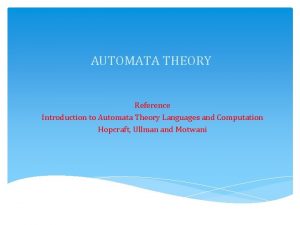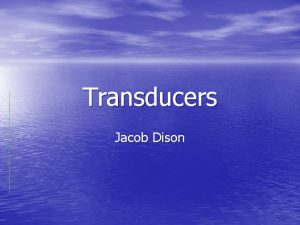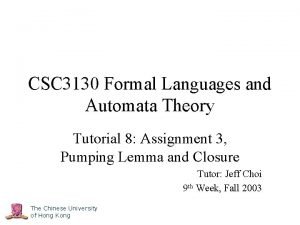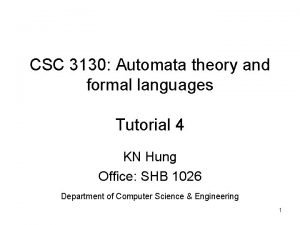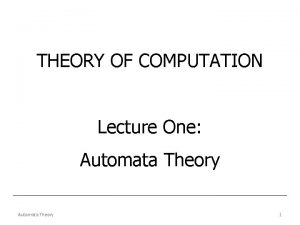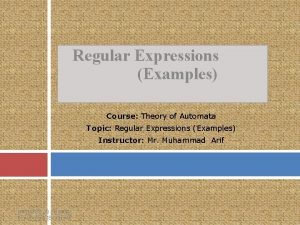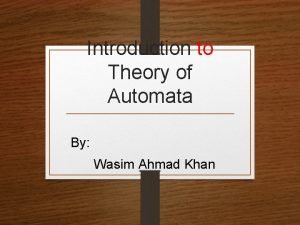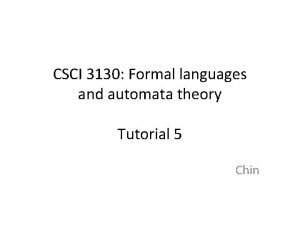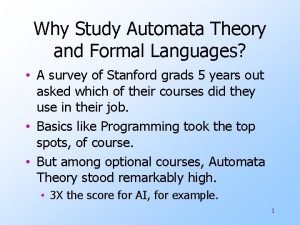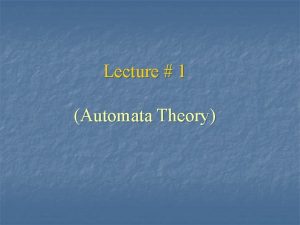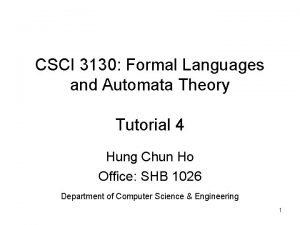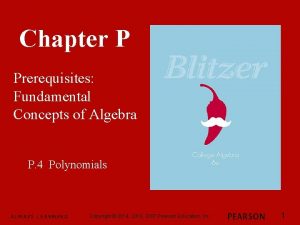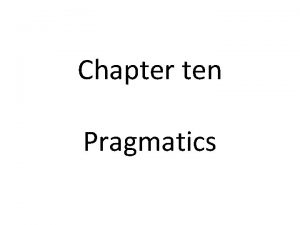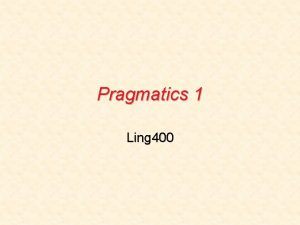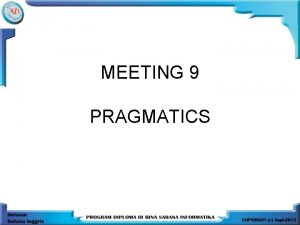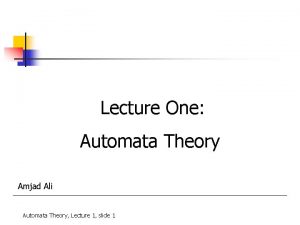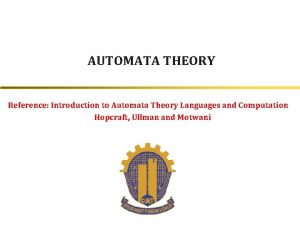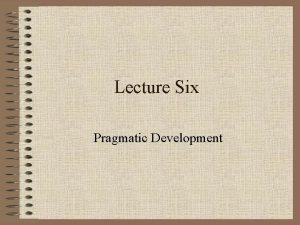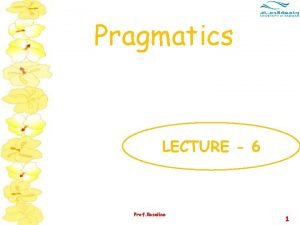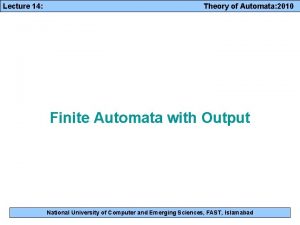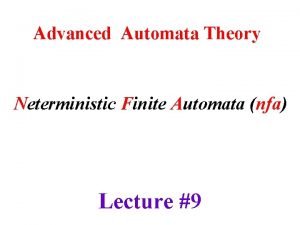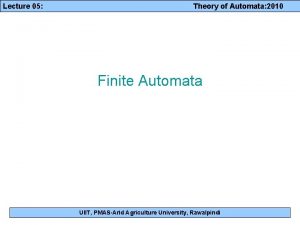LECTURE 1 THEORY OF AUTOMATA PRAGMATICS PreRequisites Text



























- Slides: 27

LECTURE 1 THEORY OF AUTOMATA

PRAGMATICS Pre-Requisites Text book Introduction to Computer Theory by Daniel I. A. Cohen Quizzes No Pre-Requisite Roughly once every week Marks Distribution Theoretical Course 25% Mid-term, 50% Final, 10% Quizzes, 10% assignments & 5% class behaviour

COURSE OBJECTIVES The major objective of this course is to introduce the student to the concepts of theory of automata in computer science. The student should acquire insights into the relationship among formal languages, formal grammars, and automata. Upon successful completion of this course, students will be able to: Understand the equivalence between Nondeterministic Finite State Automata and Deterministic Finite State Automata. Understand the equivalence between Context-Free Grammars and Nondeterministic Pushdown Automata. Appreciate the power of the Turing Machine, as an abstract automaton, that describes computation, effectively and efficiently.

WHAT DOES “AUTOMATA” MEAN? It is the plural of automaton, and it means “something that works automatically”

AUTOMATA THEORY Deals with the definitions and properties of mathematical model of computation. Examples: Finite automata, Context free grammars. Finite Automaton: Text Processing, Compilers Context Free grammars: Programming languages, AI

HISTORY In 1930’s, before the advent of computers, Alan Turing gave the idea of Turing machine (abstract computing machine) that has all the capabilities (computation) of today’s real computers. In 1940’s and 50’s more simpler kind of computing machine (Finite Automata) were suggested by researchers. Finite Automata was about the modeling of the brain’s functioning.

HISTORY In 1950’s Noam Chomsky introduced the idea of Context-Free Grammar (Formal grammar). There is a close relationship between context-free grammar and automata. The idea of Finite Automata and Formal grammar are used in the design and construction of different softwares, and Turing Machine helps us in understanding what to expect from software

FORMAL LANGUAGE A formal language is a set of strings of symbols where symbols are chosen from a set (alphabet). The key concepts in formal language are Alphabets, Strings, Empty String, length of string, power of alphabet, and the language itself.

SETS (PRELIMINARIES) A set is a group of objects, called elements (or members) of this set. For example, the students in this room form a set. A set can be defined by listing all its elements inside braces, e. g. : S ={ 7, 21, 57} The order of elements in sets do not matter – in particular, S={7, 21, 57} = {21, 57, 7}

SETS CONTINUED… The set are also represented by Venn Diagram. For two sets A and B, A is said to be subset of B if every element of A is found in B, and written as A ⊆ B. Set A is said to be proper subset of B if A is subset of B and not equal to B, written as A ⊂ B. Thus the empty set, φ, is a proper subset of every non-empty subset

EXAMPLES OF SETS The set with no elements is called the empty set and denoted by Λ The empty set is a subset of every set. The set of natural numbers N (or N): N = {1, 2, 3, . . . } The set of integers Z (or Z): Z = {. . . , -2, -1, 0, 1, 2, …} It is clear that N subset of Z

The union of two sets A and B, written AUB, is a new set containing all the elements of A and B. The intersection of two sets A and B, written A⋂B, is a new set containing the common elements of A and B. The complement of a set A, written A, is a new set containing no elements of A depending on universal set. The difference of two set A and B, written A–B, is a new set containing all the elements of A that are not found in B.

SET OPERATIONS

The power set of A is the set of all the subsets of A. Thus a set can be a member of another set. The cartesian product or cross product of two sets A and B, written Ax. B, is a new set of all pairs such that the first element belongs to A and the second belongs to B. We can have the cross product of a set with itself. The cardinality of a set is the number of elements in that set and denoted by ||.

SEQUENCE AND TUPLE A sequence is a collection of objects in some order. Unlike the sets, repetition and order of elements are very important in sequence and usually written within parentheses for example (21, 17, 4, 12) , (17, 4 , 21, 12) , (21, 17, 4, 4, 12) Are different sequences. • A finite sequence is often called a tuple. So a sequence with k elements is a k-tuple and 2 -tuple is also called pair.

LANGUAGES In English, we distinguish 3 different entities: letters, words, and sentences. � Groups of letters make up words and groups of words make up sentences. � However, not all collections of letters form valid words, and not all collections of words form valid sentences. This situation also exists with computer languages. � Certain (but not all) strings of characters are recognizable words (e. g. , IF, ELSE, FOR, WHILE …).

BASIC DEFINITIONS A finite non-empty set of symbols (letters), is called an alphabet. It is denoted by Σ ( Greek letter sigma). Example: Σ={a, b} Σ={0, 1} //important as this is the language //which the computer understands. Σ={i, j, k}

STRINGS Concatenation of finite symbols from the alphabet is called a string. Example: If Σ= {a, b} then a, abab, aaabb, ababababab

WORDS Words are strings belonging to some language. Example: If Σ= {x} then a language L can be defined as L={xn : n=1, 2, 3, …. . } or L={x, xxx, …. } Here x, xx, … are the words of L

EMPTY STRING ORNULL STRING We shall allow a string to have no letters. We call this empty string or null string, and denote it by the symbol Λ. For all languages, the null word, if it is a word in the language, is the word that has no letters. We also denote the null word by Λ.

STRING OPERATIONS Concatenation

Reverse

STRING LENGTH Length: Examples:

DEFINING LANGUAGES Example: Consider this alphabet with only one letter ∑={x} We can define a language by saying that any nonempty string of alphabet letters is a word L 1 = { x, xxx, xxxx, … } or L 1 = { xn for n = 1, 2, 3, … } Note that because of the way we have defined it, the language L 1 does not include the null word Λ.

EXAMPLE: The language L of strings of odd length, defined over Σ={a}, can be written as L={a, aaaaa, …. . } Example: The language L of strings that does not start with a, defined over Σ={a, b, c}, can be written as L={b, c, ba, bb, bc, ca, cb, cc, …}

EXAMPLE: The language L of strings of length 2, defined over Σ={0, 1, 2}, can be written as L={00, 01, 02, 10, 11, 12, 20, 21, 22} Example: The language L of strings ending in 0, defined over Σ ={0, 1}, can be written as L={0, 00, 10, 000, 010, 100, 110, …}

EXAMPLE: The language EQUAL, of strings with number of a’s equal to number of b’s, defined over Σ={a, b}, can be written as {Λ , ab, aabb, abab, baba, abba, …} The language EVEN-EVEN, of strings with even number of a’s and even number of b’s, defined over Σ={a, b}, can be written as {Λ, aa, bb, aaaa, aabb, abab, abba, baab, baba, bbaa, bbbb, …}
 Making connections
Making connections 01:640:244 lecture notes - lecture 15: plat, idah, farad
01:640:244 lecture notes - lecture 15: plat, idah, farad Relevance theory in pragmatics
Relevance theory in pragmatics Gtg
Gtg Central concepts of automata theory in flat
Central concepts of automata theory in flat Bidirectional transducers in automata theory
Bidirectional transducers in automata theory Formal languages and automata theory tutorial
Formal languages and automata theory tutorial Automata theory tutorial
Automata theory tutorial Cyk algo
Cyk algo Automata theory
Automata theory Automata theory
Automata theory Automata theory
Automata theory Valid and invalid alphabets in automata
Valid and invalid alphabets in automata Formal languages and automata theory tutorial
Formal languages and automata theory tutorial Pushdown automata
Pushdown automata Formal language
Formal language Automata theory
Automata theory Automata theory stanford
Automata theory stanford Reverse of a string in automata theory
Reverse of a string in automata theory Automata theory tutorial
Automata theory tutorial Centralized recruitment
Centralized recruitment Associate of applied science in nursing block vs integrated
Associate of applied science in nursing block vs integrated Group discussion meaning
Group discussion meaning Gcc nursing program requirements
Gcc nursing program requirements Glendale community college nursing application
Glendale community college nursing application Chapter p prerequisites fundamental concepts of algebra
Chapter p prerequisites fundamental concepts of algebra Mnemonic forceps delivery
Mnemonic forceps delivery Aecp prerequisites
Aecp prerequisites


